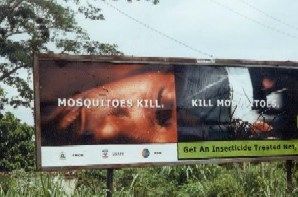Communication &ITNs Bill Brieger | 02 Sep 2014 06:44 am
Hearing, Seeing, Changing: Bednet Behavior
An important new article in Malaria Journal by colleagues at the Johns Hopkins University Center for Communications Programs gives confidence to health educators and behavior change practitioners that their interventions do make a difference. Using the 2010 Malaria Indicator Survey (MIS) from Zambia, they were able to comparing women’s reports of exposure to behavior change communication (BCC) messages and their use of insecticide treated nets (ITNs) the previous night.
 Exposure to ITN messages was focused on women who “reported hearing or seeing any malaria messages in the past six months and also cited at least one specific channel: television or radio, in the newspaper, on posters or billboards, or from peer educators and drama groups.” Using two different analytic approaches, the authors found that exposure to messages was responsible for between 12-29% of net use. They concluded that the results “illustrate that BCC programmes can contribute to national programmes seeking to increase the use of ITNs inside the home.”
Exposure to ITN messages was focused on women who “reported hearing or seeing any malaria messages in the past six months and also cited at least one specific channel: television or radio, in the newspaper, on posters or billboards, or from peer educators and drama groups.” Using two different analytic approaches, the authors found that exposure to messages was responsible for between 12-29% of net use. They concluded that the results “illustrate that BCC programmes can contribute to national programmes seeking to increase the use of ITNs inside the home.”
The recent MIS in a variety of endemic countries have taken up the task of measuring not just use of ITNs but also knowledge of the role of ITNs in preventing malaria and exposure to BCC messaging about ITNs. Similar analysis should be performed on these data sets.
 The 2010 Nigeria MIS, for example, reported that 27.9% of women reported exposure to malaria messages in 4 weeks prior to the study. Likewise 57.9% of women had knowledge that Sleeping under mosquito net prevents malaria in pregnancy (MIP). The 2012 MIS from Malawi reported that 25.3 women claimed exposure to malaria messages in past 4 weeks, and of those, 87.3% had knowledge that Sleeping under mosquito net prevents MIP.
The 2010 Nigeria MIS, for example, reported that 27.9% of women reported exposure to malaria messages in 4 weeks prior to the study. Likewise 57.9% of women had knowledge that Sleeping under mosquito net prevents malaria in pregnancy (MIP). The 2012 MIS from Malawi reported that 25.3 women claimed exposure to malaria messages in past 4 weeks, and of those, 87.3% had knowledge that Sleeping under mosquito net prevents MIP.
A 2011 survey in Ghana found that 57.3% of women claimed exposure to malaria messages in past 4 weeks, and of those 83.7% had knowledge that Sleeping under and ITN prevents MIP. A question remains though, what was the actual nature of those media efforts to which women claim exposure?
The surveys do note the broad sources of information, e.g. radio, health workers/clinic, community activities. A review of overall national malaria strategies and specific malaria BCC documents will certainly indicate that national programs and their partners intend to engage in a variety of BCC activities. The issue is whether, where and how those activities took place.
To give more validity to BCC outcomes, we must also encourage national malaria programs and their partners to document better their BCC activities so we can more easily attribute ITN behavior change itself to specific, funded interventions.